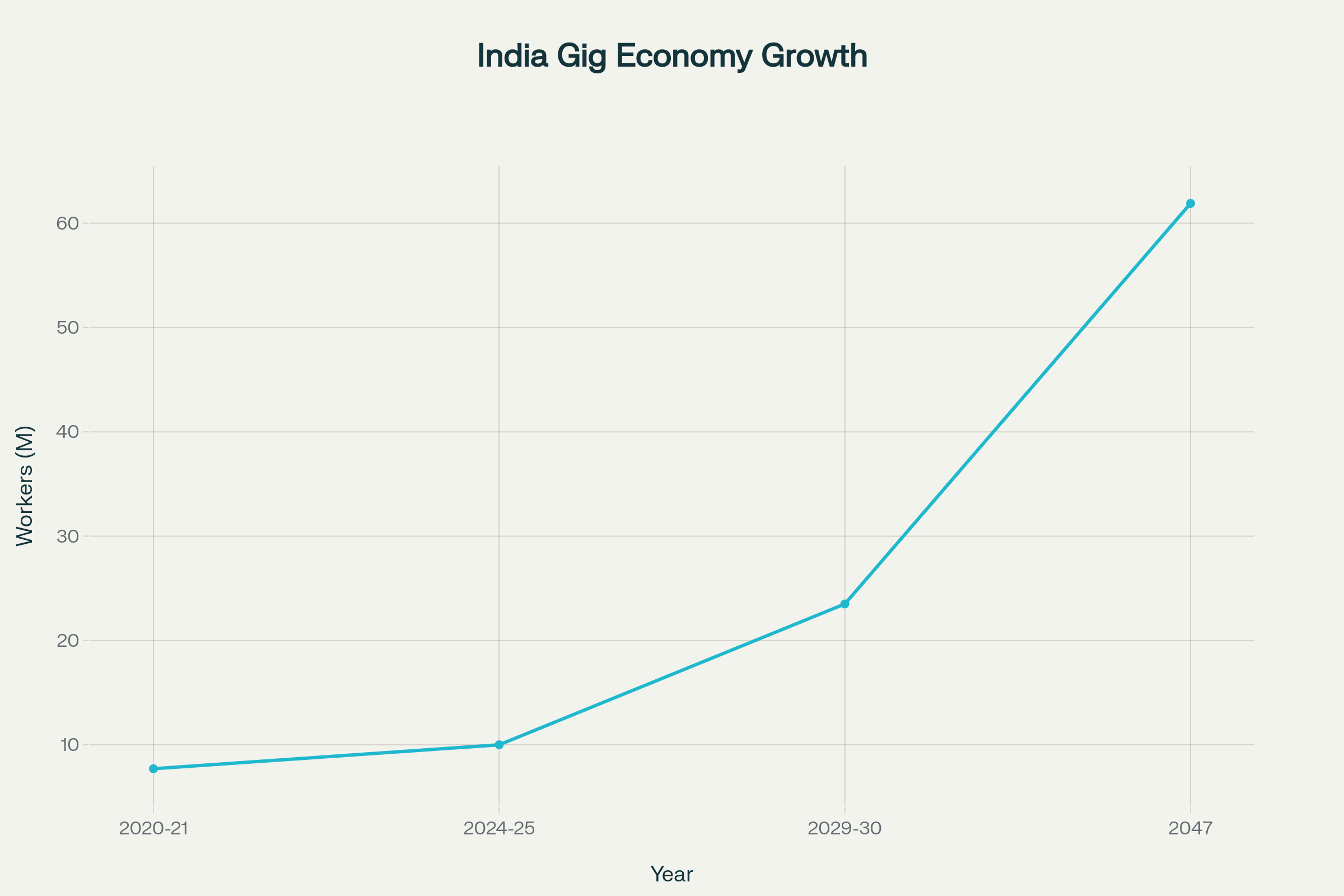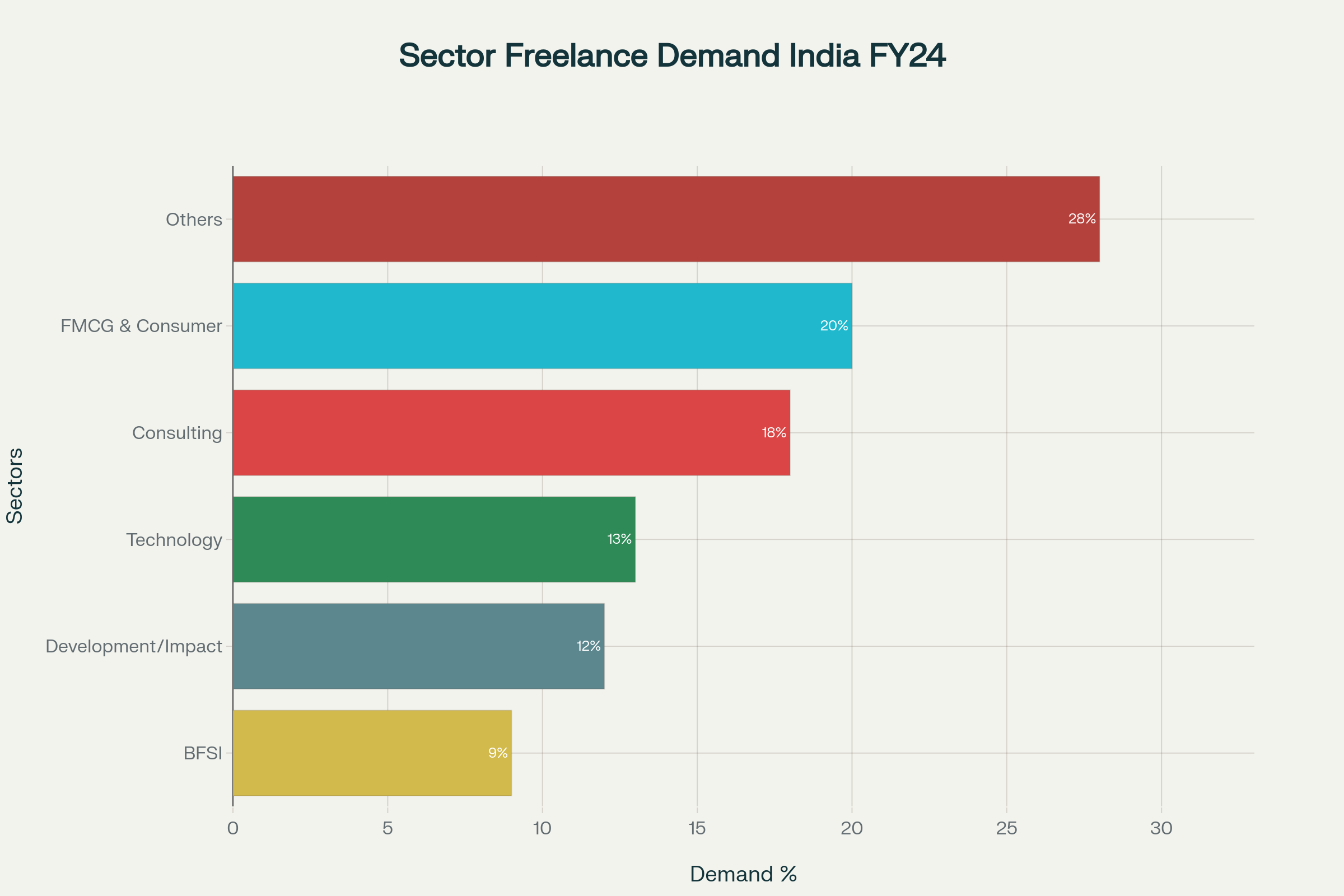
Freelancer in India 2025: Explosive Growth Trends
Freelancer in India 2025: Explosive Growth Trends
Future of Freelancer in India: A Growing Economic Revolution
India stands at the edge of a major work revolution. The country’s freelance sector is not just growing – it’s exploding with opportunities. With millions of skilled professionals choosing freedom over fixed jobs, India is quickly becoming the world’s biggest freelance hub. This shift is changing how people work, earn, and build their careers.
The numbers tell an amazing story. India had just 7.7 million gig workers in 2020-21, but this figure is set to reach 23.5 million by 2029-30. Even more exciting, by 2047, experts predict that 61.9 million Indians will be working as freelancers, making up nearly 15% of the country’s non-farm workforce. This growth represents one of the fastest job market changes in India’s history.
Current State of Indian Freelancing Market
India’s freelance market is worth big money and growing fast. The freelance platform market alone generated USD 187.5 million in 2023 and is expected to jump to USD 775.6 million by 2030, growing at 22.5% each year. This makes India one of the top three freelancing markets globally, accounting for 3.8% of the worldwide freelance economy.
The country now hosts over 15 million freelancers, making it the second-largest freelance market after the United States. What makes this even more impressive is that Indian freelancers contribute about 40% of all freelance jobs offered worldwide. The global market for freelancers is worth $2-3 billion, and India accounts for $1 billion of this massive pie.

Indian freelancers are not just competing – they’re winning. The average Indian freelancer earns $22 per hour, which is higher than the Asia average of $19 per hour. In some skilled areas like finance, Indian freelancers charge $71 per hour compared to the global average of $41, and in marketing, they earn $47 per hour versus the global average of $34. This premium shows that global clients recognize and value Indian work quality.
Demographics Driving the Change
The face of Indian freelancing is young and energetic. A massive 40% of Indian freelancers are under 25 years old, with another 39% falling in the 25-35 age group. This means nearly 80% of India’s freelance workforce consists of millennials and Gen Z professionals who value flexibility over traditional job security.
This young workforce brings digital skills and global thinking to their work. They grew up with smartphones and internet access, making them perfect for the digital freelance economy. Unlike older generations who preferred stable, long-term jobs, today’s youth want flexibility, independence, and multiple income sources.
The skill distribution among Indian freelancers shows strong technical abilities. Web and graphic design lead with 13% market share, followed by information technology at 12%, and content writing at 11%. Digital marketing and data analysis are also growing rapidly, showing that Indian freelancers are moving toward high-value services.
Women’s Growing Participation
One of the most exciting trends is the rapid growth of women freelancers in India. While women currently make up only 22-30% of the freelance workforce, their numbers are growing much faster than men’s. Female consultant registrations jumped by over 300% in FY24 compared to FY22, while male registrations grew by 225% during the same period.
About 39% of women freelancers prefer part-time roles, showing their desire for flexible work that fits with family responsibilities. This is especially important for educated women who want to continue their careers while managing household duties. Many highly educated women with masters and doctorate degrees turn to freelancing when they cannot pursue regular jobs due to family and social obligations.
However, challenges remain. Women freelancers still face a gender pay gap, earning about 81% of what their male colleagues make. Male consultants charge 30-35% higher project fees than women on average. This gap is mainly due to women’s tendency to negotiate less and settle for lower rates, plus the perception that women may be less flexible for weekend meetings or late evening calls.
Sector-wise Opportunities and Growth
The freelance economy spans across multiple sectors, each offering unique opportunities. The top five sectors driving freelance demand in India are consumer goods and FMCG (20%), consulting (18%), technology (13%), development and impact work (12%), and banking and financial services (9%).

Technology and IT Services remain India’s strongest suit. The country has long been known as a global IT hub, and this advantage extends to freelancing. Services include web development, mobile app development, software engineering, and cybersecurity. With competitive pricing and high-quality output, Indian IT freelancers are in high demand worldwide.
Creative and Content Services are booming as businesses focus on digital marketing. This includes graphic design, content writing, video editing, and digital marketing services. The rise of social media and online marketing has created huge demand for creative professionals who can help brands build their online presence.
Consulting and Professional Services show the fastest growth rates. Independent consultants in management, finance, and legal services are finding more opportunities as companies prefer project-based expertise over full-time hires. This sector shows how freelancing is moving beyond basic tasks to high-value strategic work.
Healthcare and Education sectors are emerging as new opportunities. Telemedicine consultations and online tutoring have grown rapidly, especially after COVID-19. These sectors offer stable income and social impact, attracting professionals who want meaningful work.
Technology as the Great Enabler
Digital platforms have solved the three biggest problems that freelancers traditionally faced: finding clients, managing projects, and getting paid. Platforms like Upwork, Freelancer, and Fiverr have created a global marketplace where Indian professionals can compete for international projects.
The “Jio effect” changed everything for Indian freelancers. Cheap data and affordable smartphones meant millions of Indians could suddenly access the same digital tools regardless of their location. A delivery worker in a small town now carries the same internet-powered device as a software developer in Bangalore.
Government initiatives like Digital India have also helped freelancing grow. The platform created opportunities for anyone with computer knowledge, internet access, and an Aadhaar card to find freelance work. More than 68% of freelancers depend on social media to find suitable work opportunities.
Artificial Intelligence and automation tools are becoming more accessible, helping freelancers work faster and more accurately. These tools can handle routine tasks, allowing freelancers to focus on high-value work that requires human creativity and judgment.
Must Read: 7 Tips to Grow Your Business in 2025
Economic Impact and Future Projections
The economic impact of freelancing goes beyond individual earnings. The gig economy is valued at approximately USD 20 billion in India and is set to grow by 17% annually until 2027. By 2030, the total transaction volume could reach $250 billion, contributing 1.25% to India’s GDP.
This growth could create around 90 million jobs in the long term, helping India address its employment challenges. With the formal sector struggling to create enough jobs, freelancing offers an alternative path for millions of young Indians entering the workforce.
The government recognizes this potential. NITI Aayog estimates show strong policy support for the gig economy, with new social security measures being introduced for gig workers. The Code on Social Security, 2020, defines gig workers and platform workers for the first time, providing benefits like life insurance, health coverage, and old age protection.
Major Challenges Facing Indian Freelancers
Despite the bright prospects, Indian freelancers face several significant challenges that need urgent attention.
Payment Issues top the list of problems. About 58% of freelancers experience payment delays, often spending valuable time chasing clients for unpaid dues. High transaction fees from international payment processors like PayPal and Payoneer also eat into freelancers’ earnings. Many Indian freelancers need better local payment solutions like UPI to make transactions cheaper and faster.
Skill Mismatches create barriers for many potential freelancers. While India has many technically skilled professionals, they often lack business skills or marketing knowledge needed to grow their freelance ventures. Poor recommendation algorithms on global platforms sometimes lead to mismatched projects, reducing success rates for Indian freelancers.
Limited Regional Support affects freelancers outside major cities. Most global platforms lack support for regional languages and don’t understand local market needs. This creates barriers for talented professionals in smaller towns and rural areas who could contribute to the freelance economy.
Competition and Rate Pressure is intense. About 69% of Indian freelancers report facing greater competition, slightly higher than other regions. This sometimes leads to price wars where freelancers undercut each other, reducing overall earnings for everyone.
Lack of Social Security remains a big concern. Unlike regular employees, freelancers don’t get benefits like provident fund, health insurance, or paid leave. This makes freelancing risky for those who need stable income and security.
Government Initiatives and Policy Support
The Indian government is taking steps to support the growing freelance sector. The Digital India initiative has improved digital infrastructure and helped more people access online opportunities. Various skill development programs under Skill India and Startup India are helping people develop freelancing capabilities.
The new social security code specifically addresses gig workers’ needs. It provides legal recognition for platform workers and gig workers, offering benefits like accident insurance, health coverage, and old age protection. This is a major step toward making freelancing a more secure career option.
Tax policies are also becoming friendlier for freelancers. The government is working on simpler GST procedures and better tax compliance systems for small businesses and individual professionals.
Future Opportunities and Trends
Several trends will shape the future of freelancing in India over the next decade.
AI and Automation Integration will create new opportunities while changing others. Freelancers who learn to work with AI tools will become more productive and valuable. However, those in routine tasks may need to upskill to stay relevant.
Remote Work Normalization will continue expanding opportunities. The COVID-19 pandemic showed companies that remote work is effective, opening more global opportunities for Indian freelancers.
Specialized Skills Demand is growing rapidly. As businesses become more complex, they need experts in narrow fields like cybersecurity, data privacy, and digital transformation. Freelancers with these specialized skills will command premium rates.
Green and Sustainable Jobs represent a new frontier. With climate change concerns growing, businesses need freelancers who can help with sustainability initiatives, green marketing, and environmental compliance.
Rural and Semi-Urban Growth offers untapped potential. As internet connectivity improves in smaller towns, more talented professionals from these areas will join the freelance economy, bringing diverse perspectives and competitive rates.
Building a Sustainable Freelance Career
For Indians considering freelancing, several strategies can ensure long-term success. Skill Specialization is crucial – freelancers should focus on developing deep expertise in specific areas rather than being generalists. Building Strong Online Presence through professional profiles, portfolios, and client testimonials helps attract better projects.
Networking and Collaboration with other freelancers and industry professionals creates referral opportunities and knowledge sharing. Continuous Learning is essential as technology and market needs change rapidly. Financial Management skills help freelancers handle irregular income and plan for the future.
Quality Focus over price competition helps build reputation and command better rates. Client Relationship Management ensures repeat business and positive references, which are crucial for long-term success.
Conclusion
The future of freelancing in India looks incredibly bright. With strong government support, growing global demand for Indian skills, and a young, tech-savvy workforce, India is set to become the world’s largest freelance economy. The sector will grow from 23.5 million workers by 2029-30 to potentially 61.9 million by 2047, creating massive opportunities for economic growth and employment.
However, success requires addressing current challenges like payment issues, skill gaps, and social security concerns. By solving these problems and continuing to invest in digital infrastructure and skill development, India can unlock the full potential of its freelance revolution.
For young Indians entering the job market, freelancing offers an exciting alternative to traditional employment. It provides flexibility, global exposure, and potentially higher earnings. For the country, a thriving freelance sector means faster economic growth, better employment opportunities, and increased global competitiveness.
The freelance revolution in India is not just about changing how people work – it’s about creating a new economic model that values skills, creativity, and independence. As more Indians embrace this change, the country moves closer to becoming a truly modern, flexible, and dynamic economy ready for the challenges of the 21st century.










